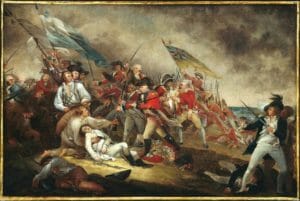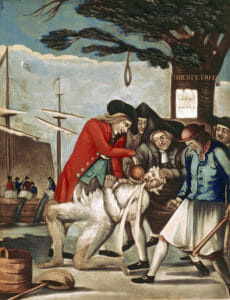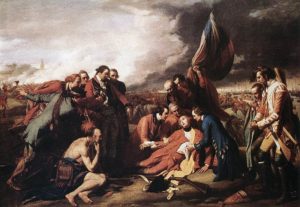American History for Truthdiggers: Independence and Civil War (1775-1783)
How the social and military experience of revolution shaped the diverse American republic. “The Surrender of Lord Cornwallis,” an 1819 painting by John Trumbull. An American officer on horseback looms over the defeated British general as George Washington (rear, right of center) looks on. The principals are flanked by French troops on the left and members of the Continental Army on the right.
“The Surrender of Lord Cornwallis,” an 1819 painting by John Trumbull. An American officer on horseback looms over the defeated British general as George Washington (rear, right of center) looks on. The principals are flanked by French troops on the left and members of the Continental Army on the right.
Editor’s note: The past is prologue. The stories we tell about ourselves and our forebears inform the sort of country we think we are and help determine public policy. As our current president promises to “Make America great again,” this moment is an appropriate time to reconsider our past, look back at various eras of United States history and re-evaluate America’s origins. When, exactly, were we “great”?
Below is the fifth installment of the “American History for Truthdiggers” series, a pull-no-punches appraisal of our shared, if flawed, past. The author of the series, Danny Sjursen, an active-duty major in the U.S. Army, served military tours in Iraq and Afghanistan and taught the nation’s checkered, often inspiring past when he was an assistant professor of history at West Point. His wartime experiences, his scholarship, his skill as a writer and his patriotism illuminate these Truthdig posts.
Part 5 of “American History for Truthdiggers.” / See: Part 1; Part 2; Part 3; Part 4.
* * *
“The war [of independence] was not just about home rule, but about who would rule at home.” —Historian Carl Becker
What sort of revolution was it? Radical or conservative? Military or social? Earnestly democratic or hypocritical farce?
Perhaps a bit of them all. What it most certainly was not was what is presented in the comfortable, patriotic, grade-school yarn to which we’ve all grown accustomed. Yet, neither was it something out of a fable of white privilege that can be dismissed outright.
Let us begin with the famous painting above, commissioned by the U.S. Congress and displayed in the Capitol Rotunda. This rendering prompts some questions: Who, exactly, won the war and what sort of war was it? What’s not depicted? And why? The artist captures the moment of British surrender after the Battle of Yorktown in 1781. It’s all so neat, so symmetrical, with regular Continental Army soldiers mounted and standing at right, and equally spiffy French troopers, replete with clean white uniforms, at left. The humbled redcoats stand beneath an American officer and offer their surrender as a mounted Gen. George Washington observes from the rear, at right.
Were this the only portrait available for posterity, the viewer might assume the War of Independence was a rather conventional, military affair, waged tidily between two gentlemanly armies. The popular image is something like this: The Continental Army—with some help from the French—vanquished the Brits and won a new, independent nation. There was no dirt, no grime, nothing messy or complex. There were no women, no blacks, no Native Americans, certainly no loyalists or uncouth colonial militiamen involved.
Perhaps this is how Americans like to remember the Revolution, how elementary school teachers transmit this epic past.
As we’ve seen in earlier installments in this Truthdig series, the way we remember the past is as fascinating and instructive as the reality of events. This is particularly true of the American Revolution, which, I would suggest, is America’s second origins myth, a saga of colonial liberty smiting British tyranny once and for all, a story topped only by the initial settlement of the colonies. Would that it were so simple. …
When evaluating the American Revolution, we must essentially parse out comprehensive answers to the following questions: How and why did rebels—whose army never won a battle in the open field—defeat the most powerful empire in the Western World? How was the social and military experience of revolution lived and experienced by a diverse colonial population? And, finally, what did it mean to “win,” and who exactly were the war’s winners and losers? In seeking to answer these questions, we may not always like what we find, may become confused by the cluttered conglomeration of the Revolutionary experience. Still, perhaps we will also unearth something profound about who we were, as Americans, who we strove to be, and how far we’ve come in achieving our great revolution.
Blood Has Been Shed: From Lexington to Bunker Hill
In installment four of this series we left our anguished—and hopelessly divided—American colonists on the verge of rebellion, just 12 years after the defeat of France in the Seven Years’ War. With the benefit of hindsight, revolution appears all but inevitable; yet, nothing was predetermined. Some spark was needed to engulf the continent in bloodshed. It would come in Massachusetts.
On the eve of war, the British, like so many regular imperial armies before them, believed they could intimidate the rebels with a display of impressive uniforms, lockstep marching and a basic show of force. In and around Boston, the British sought to seize large stores of colonial arms and, in that strategic vein, marched out of the city toward the village of Concord in April 1775. They bet wrong, and the overt show of military force (as Americans would learn in Baghdad in the 21st century) actually raised tensions, radicalized the populace and caused conflict.
Besides, seizing centralized armories would not, in itself, work in America, due to one characteristic of the colonists: They were armed. Consider, for a moment, the radical ramifications of an armed populace. The Americans were unique in that, unlike Englishmen, Scots or Irishmen, nearly all white men were gun owners. The tools, so to speak, were there. It seemed war would come eventually; it was a matter of when and where.
At about 4 a.m. on April 19, 1775, the British regulars, on the road to Concord, ran into a paltry, colonial show of force: 70 or so militiamen had gathered—with muskets—on the Lexington town green. A British officer ordered them to disperse. They did not. No one knows who fired first, but it was the seasoned British regulars who fired last, at least for the moment. When the smoke cleared, several colonists—English subjects—lay dead, more were wounded, and the rest had fled. The road to Concord lay open, and the British took it.
Then, on the way back to their base in Boston, something happened. Colonists from neighboring towns, using hit-and-run tactics on home turf they knew thoroughly, inflicted hundreds of casualties on the withdrawing British redcoats. It was a bloody day, and it changed the course of American history.
After Lexington and Concord, both sides sought to use the day’s events as propaganda to drum up support. Both told lies. Some colonists claimed that marauding redcoats had slaughtered women and children in their path. For their part, some Britons told tales of rebel colonists scalping—and in some cases cannibalizing—surrendered prisoners.
And so, as is often the case, matters after this first draw of blood took on a chaotic momentum. Many formerly lukewarm patriots from the other, less zealous colonies now stood with their firebrand cousins in rebellious Massachusetts. It was to be war. A war among, and for, the loyalty of the people—the sort of war that doesn’t end well.

The conflict centered in Boston for the next several months, and the once overconfident British learned their lesson again in the famous Battle of Bunker Hill (which was actually fought on Breed’s Hill) in June 1775. Observe the painting above, like the Cornwallis painting the work of John Trumbull, essentially the official artist of the Continental Army. In this romanticized depiction, which has become visual gospel of the patriot cause, the brutal Brits—accompanied by dark clouds—charge the hill and attempt to bayonet a dying Gen. Joseph Warren. Warren, of course, is clad in virgin white and lies in the Christlike lamentation pose so popular in paintings of the time.
In the battle the attacking British chose a frontal assault, rather than Gen. Henry Clinton’s preferred flanking maneuver, and eventually dislodged the colonists. In a sense the British won—they held the field—but it was a pyrrhic victory. More than 1,000 British and 400 Americans were killed or wounded. Though it occurred just two months after the fighting commenced, Bunker Hill would prove to be the bloodiest single-day encounter of the entire war.
This, before the colonies had even declared independence! Indeed, that was to come much later, some 13 months afterward, in July 1776. Just one month after the combatants soaked Breed’s Hill with blood, the colonists sent the famous “Olive Branch” petition to King George III, seeking a negotiated solution to the conflict. Most colonists still viewed themselves as both American and British. Few expected outright detachment from the empire. Only the timing was poor. The king, having received word of the bloodshed in Boston, ignored the petition and instead declared the colonies in rebellion in August 1775. The king may, in fact, have passed up an opportunity to de-escalate the rebellion and divide the colonists. Instead, the patriots among them moved irrevocably toward independence.
The Decision for Independence, the Issue of God-Given Equality
“All men are created equal. They are endowed by their Creator with certain unalienable rights; among these are life, liberty, and the pursuit of happiness.” —Thomas Jefferson (1776) and Vietnamese revolutionary Ho Chi Minh (1945)
It was in these fiery times, after Lexington/Concord and Bunker Hill, that Thomas Paine penned “Common Sense.” This wildly popular tract—it sold 100,000 copies in a single year, estimated to be the equivalent of 12 million copies today—was concise and accessible, written in a plain language that spoke to a widely literate American population. In a sense, Paine was a strange messenger for 18th-century colonists. A Briton who had recently arrived in America, Paine had, until January 1776, largely been a failure. And, for the times (heck, for today!), he was a radical; an atheist who called for abolition of slavery and an early form of universal health care, Paine had one more seemingly radical idea: American independency.
Paine’s “Common Sense” described the logic of division from Great Britain and dramatically extolled the virtue of the American Cause:
There is something exceedingly ridiculous in the composition of monarchy … so far as we approve of monarchy, that in America the law is king … but there is something very absurd in supposing a continent to be perpetually governed by an island.
The Cause of America is in great measure the cause of all mankind. … The sun never shined on a cause of greater worth. … We have it in our power to begin the world over again. …
Wow. What it did, besides motivate the patriots, was to logically bridge the gap to a declaration of full independence from the British Empire. Within months, the Continental Congress in Philadelphia would come to the same conclusion, and a young Virginian planter—and slaveholder—named Thomas Jefferson would be nominated to pen the proclamation.
What sort of document was this? For one thing, the decision to write it was itself radical. This was, at root, an act of treason to which dozens of men courageously signed their names. It was a lengthy list of grievances against the king himself, an explanation for their decision to rebel. But it is the document’s preamble that we remember, and this, of course, was a thorny matter. The preamble speaks of all men being created equal, and certainly the Founding Fathers did not mean to extend political rights to women. But which men? White ones, of course, perhaps with a little property, or, in the more progressive colonies, perhaps even the landless. Slaves or free black men (one-fifth of the population) didn’t count; nor did the “savage” Native Americans beyond the Appalachian frontier. A simple, and not altogether incorrect, conclusion would be that the Declaration of Independence was, at root, a hypocritical document. But there is much more to it.
The preamble and main prose of the declaration tells us many things. Here is one: This was a war about ideas more than territory, and ideological wars tend to be long and brutal in their prosecution. It is—as I’ve learned firsthand across the contemporary Middle East—a very difficult thing indeed to defeat an enemy fighting fundamentally for ideas.
The attribution of the quotation I used at the start of this subsection is shared by Jefferson and Ho Chi Minh, the Vietnamese revolutionary communist and sworn enemy of the United States. Ho directly quoted the line from Jefferson’s preamble in his own declaration of independence, from the French Empire in 1945. I included Ho because he serves a purpose: to demonstrate that the meaning and interpretation of words and sentiments change through the ages. A non-Christian Asian would certainly have found himself excluded from the fruits of America’s 18th-century revolution. And yet, perceiving a universalism in the document’s preface, Ho was inspired by Jefferson’s words nearly two centuries later. This, perhaps, is the American Revolution as its imperfect best.
The Civil War of 1776: Loyalists and Patriots in Revolution
“Upon the whole, if we allow [at most] two-thirds of the people to have been with us in the revolution, is not the allowance ample? Divided we have ever been, and ever must be.” —John Adams (1813)
Benjamin Franklin was, perhaps, along with George Washington, the most famed and avowed patriot of them all. For all that, Franklin’s own family divided over the revolution, and one of his most avowed critics was his own son: the royal governor of New Jersey and a staunch loyalist. If even the Franklin family could tear asunder in the tide of revolution, then certainly something profound was afoot in the colonies.
In addition to being a war for independence, the American Revolution was, and at the time often was referred to as, an American civil war. This was a revolutionary war in the most basic sense, full of armies, guerrillas, militias, local strongmen and counterinsurgents. While quite 18th century in its flavor and makeup, it was not unlike contemporary events in Iraq or Syria. Though rarely thought of in this way, as a proportion of the population nearly as many Americans fought one another in the Revolution as in the Civil War of 1861-65.
To understand this, one must consider the extent and power of loyalism of one stripe or another. A bit of mental math is in order. We’ll stick with the men. Let us assume that 50 percent of white men were patriots. The fifth of the population that was black mainly sided with the British. That takes our calculation of patriots down to only 40 percent of the male population, and, of course, that excludes the Native Americans (who were, admittedly, not considered in colonial censuses), who were also, as we’ll find, generally allied with the British. In other words, whether in the lead-up to or in the midst of the revolution, the male patriots probably did not constitute a majority.
We often imagine the loyalists to the British cause to have been ultraconservative aristocrats, but in reality they came from all social ranks, classes and races and had varied levels of devotion to the imperial cause.
There were many reasons to remain loyal: devotion to king and crown, business connections with the imperial bureaucracy, caution, apathy and, sometimes, frustration with the excesses of the patriot masses. We must remember that no more than half the (white) colonists were outright patriots. Yet rebel crowds (or mobs, depending on one’s point of view) from that fraction took it upon themselves to not just protest but take up arms, to engage in acts of violence and, frankly, to enforce adherence to their own cause. This drew the ire of many a loyalist—or even neutral—observer. Consider a brilliant satire penned by New York loyalists in 1774 and titled “At a Meeting of the True Sons of Liberty.” The authors mock the patriot penchant for dramatic proclamations and list 15 farcical “resolutions.” The 15th, and final, is instructive:
RESOLVED, lastly, that every Man, Woman, or Child, who doth not agree with our Sentiments, whether he, she, or they, understand them or not, is an Enemy to his Country, wheresoever he was born … and that he ought at least to be tarred and feathered, if not hanged, drawn and quartered; all Statutes, Laws and Ordinances whatsoever to the contrary notwithstanding.
The loyalists and the many fence sitters—the latter group surely had sizable numbers—found the patriots exhausting and intrusive. Some took up arms for the British cause, others disseminated loyalist pamphlets and many held their tongues until it was all over.
Often, neutrality or conscientious loyalism was seen by the patriots as unacceptable. With British regulars pinned down and concentrated by the mere existence of Washington’s Continental Army, patriot militias policed allegiance to the rebellion in unoccupied towns and villages. It is not that there weren’t plenty of loyalists; it’s that the British always overestimated the number prepared to throw in their lot militarily with the fleeting, ever-on-the-move British army. By trying hard to raise such loyalist units, the British ended up fomenting a civil war, while lacking the troop numbers and mobility to back their colonial allies in the distant cities and hamlets.
Even in the South, where it was believed (correctly, to some extent) that loyalism ran strong, the British could only capture territory and then move on, leaving the task of securing it to local loyalists. Consider it an “Americanization” strategy on par with the U.S. Army’s “Vietnamization” strategy in the Vietnam War, in which U.S. forces sought to hand off territory and responsibility to their local allies in South Vietnam. Once the British (or, later, the U.S. military in Vietnam) left an area, trouble arose in the rear as rebel terrorism was often met by loyalist retaliation as a cycle of civil war gathered its own chaotic inertia.
Brutal it was, and bloody it could be, but it might have been much worse. Part of the ultimate explanation for British defeat must lie with the generals’ decision—as gentlemen—not to unleash many of the most vicious and violent loyalist militias on the patriot populace in a sort of total war. The British, even late in the war, continued to see the colonists as misguided countrymen and hoped at some point to reconcile, not shatter, American society.
Still, in the South in particular, the addition—as we shall see in next week’s installment—of revolting slaves into the civil maelstrom ushered in the nastiest phase of the war. More Americans died in this communal aspect of the conflict than in British-American conventional battles. Indeed, in the Deep South, the Continental Army had serious recruiting troubles, as Southern patriots were more concerned with policing and protecting against rebellious slaves than in directly fighting for the gallant cause of American independence.
What, then, are we to make of these other, forgotten Americans: the slaves, the Indians, the women? How did they perceive this revolution or, more aptly, this civil war? Our next installment will deal with these questions and ponder an issue at the center of the conflict: Exactly whose revolution was it?
* * *
Normally, installments in “American History for Truthdiggers” appear at two-week intervals. However, next Saturday Truthdig will publish an article by Danny Sjursen completing his treatment of the American Revolutionary War. Subsequently, postings will return to the original schedule of every other Saturday.
* * *
To learn more about topics in the above article, consider the following scholarly works:
● James West Davidson, Brian DeLay, Christine Leigh Heyrman, Mark H. Lytle and Michael B. Stoff, “Experience History: Interpreting America’s Past,” Chapter 7: “The American Revolution, 1775-1783” (2011).
● Alfred Young and Gregory Nobles, “Whose American Revolution Was It? Historians Interpret the Founding” (2011).
● Edward Countryman, “The American Revolution” (1985).
● Gary B. Nash, “The Unknown American Revolution: The Unruly Birth of Democracy and the Struggle to Create America” (2005).
● John Shy, “A People Numerous & Armed: Reflections on the Military Struggle for American Independence,” revised edition (1990).
● Jill Lepore, “The Whites of Their Eyes: The Tea Party’s Revolution and the Battle over American History” (2010).
Maj. Danny Sjursen, a regular contributor to Truthdig, is a U.S. Army officer and former history instructor at West Point. He served tours with reconnaissance units in Iraq and Afghanistan. He has written a memoir and critical analysis of the Iraq War, “Ghost Riders of Baghdad: Soldiers, Civilians, and the Myth of the Surge.” He lives with his wife and four sons in Lawrence, Kan. Follow him on Twitter at @SkepticalVet and check out his new podcast, “Fortress on a Hill,” co-hosted with fellow vet Chris “Henri” Henrikson.
[The views expressed in this article are those of the author, expressed in an unofficial capacity, and do not reflect the official policy or position of the Department of the Army, Department of Defense, or the U.S. government.]
Your support matters…Independent journalism is under threat and overshadowed by heavily funded mainstream media.
You can help level the playing field. Become a member.
Your tax-deductible contribution keeps us digging beneath the headlines to give you thought-provoking, investigative reporting and analysis that unearths what's really happening- without compromise.
Give today to support our courageous, independent journalists.






You need to be a supporter to comment.
There are currently no responses to this article.
Be the first to respond.